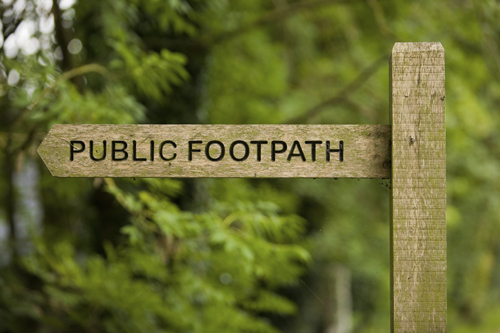Latest News
Land and Property Professionals
We sell, rent, manage, survey, plan and advise...what can we do for you?
We sell, rent, manage, survey, plan and advise...what can we do for you?

In order for a new public right of way to be claimed, there are several tests used to satisfy that there is sufficient evidence the route has been enjoyed by the public without challenge from the landowner.
Firstly, it must be shown that the use of the route has been undertaken for a minimum period of 20 years, without interruption. Secondly, it must be proven that the route has been used without secrecy, force or the landowner’s permission.
The onus is on the landowner to prove that they have actively tried to prevent third parties from acquiring rights over their property. It is therefore imperative that landowners are diligent and proactively show that they have no intention of allowing a new public right of way on their land.
There are several ways to do this:
1. Signs & Notices
Erecting a sign or notice which explicitly states that public access is prohibited can be effective, but it must be maintained and sited near the land that it is looking to protect.
2. Preventing Access
Locking gates or blocking the access to the route can help to express that the landowner does not want that section of their land dedicated as a public right of way.
3. Landowner Statements
Completing a Landowner Statement under Section 31 (6) of the Highways Act 1980 (for public rights of way) and/or Section 15A of the Commons Act 2006 (for village greens). The statement is lodged with the relevant local authority as a record of the public rights of way across a property.
By depositing a statement with the local authority, a landowner can legally protect themselves from inadvertently granting any new rights of way on their land. However, this does not affect any existing claims of 20 years’ use. Effectively, the landowner statement draws a line in the sand to prevent any new dedications from being made and is renewed every 20 years.
4. Permissive Rights of Way
If a landowner gives the public permission to use a particular route, then the public’s ability to claim a public right of way is limited. This may be useful if there are particular routes which the landowner is willing to allow the public to use but where they do not want that right to become permanent. It is important to document permissive paths and also erect signs on the land confirming the use of the route is by permission.
Although access to the countryside via public rights of way can be beneficial in increasing the exposure of rural landscapes and interest from the public, it is important that the routes used are in locations which allow the landowner continued use of the land with minimal interruption. Therefore, if landowners wish to limit the designation of new public rights of way they must be proactive in their approach to managing public access.
For more information or to find out how our Rural Property & Business department can help you, please contact Katie.
Back to articlesFor further information please contact: